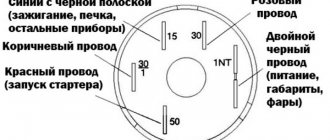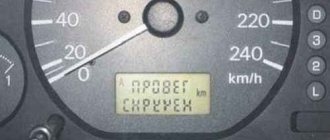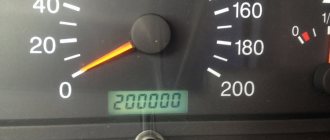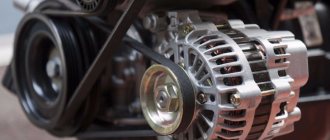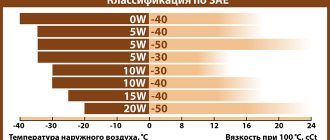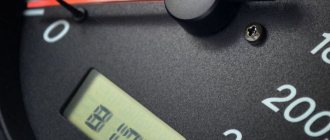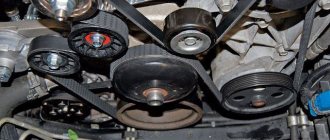How the device works
Odometer - this is how you can briefly determine the functional purpose of the odometer.
It is an odometer, and not a speedometer - as some people are used to thinking! — keeps track of the kilometers wound on the wheels and displays them on the dashboard indicators of cars and trucks. At the same time, the device records two important indicators: the current (daily) mileage and the total (total) mileage of the car in kilometers.
Structurally, the operation of the odometer is ensured by:
- magnetic car wheel revolution counter;
- a speed fixing controller associated with it;
- 2 indicators with indications of kilometers traveled, mounted in the speedometer socket on the front panel of the vehicle.
IMPORTANT! The “daily” odometer mileage is reset to zero automatically when the indicator readings reach a certain value. In all other cases, the readings can be “reset to zero” at the driver’s request. It is impossible to reset the total mileage readings on modern cars without special intervention!
Digital information on the odometer indicators is of great practical importance for the competent operation of vehicles:
- The total mileage indicators allow the car owner to accurately determine the maintenance schedule for his “iron” friend; indirectly, they characterize the degree of wear and tear (which is not always to the benefit of the car owner))
- Daily readings enable the driver to determine the distance from point A to point B; independently check fuel consumption per 100 km, etc.
The principle of operation of the odometer is based on a strictly established fact: the car wheel makes the same number of revolutions on each kilometer of the road, regardless of its speed! Knowing the actual number of revolutions, it is not difficult to calculate the length of the path traveled, i.e. car mileage.
It is the number of wheel revolutions that is taken into account by the odometer counter while the car is moving; the controller records and converts them into kilometers, displaying them in digital format on the control panel indicators.
What about them?
Many car enthusiasts may be interested in how the issue of twisted car mileage is regulated abroad. As we have already said, in many developed countries there is a responsibility for adjusting the mileage of a car at the legislative level. For example, in European countries, it is not legal to twist mileage, and in accordance with EU regulations, there is liability for this in the form of a fine. Also, all technical auto centers are required to report the fact of detecting a mileage adjustment to the relevant services.
Also, unlike Russia, in many European countries (not all) there are local laws regulating the activities of companies that provide services for adjusting mileage or setting a certain mileage in case of replacing the electronic unit responsible for the odometer. For example, in the UK, in order for the owner to adjust the mileage with the company providing this service, he must submit documents from the technical center, which must give an opinion on the last recorded mileage before the electronic unit broke down.
But, for example, one of the strict laws regulating liability for adjusting the odometer was adopted in Germany, where criminal liability is provided for this (up to 1 year of imprisonment and a large fine). As a result, companies that previously provided services for adjusting car mileage were forced to leave the German market. For example, many companies have gone to work in Poland, where there is no criminal liability for mileage misrepresentation. The average cost of mileage adjustment in Poland is 100 euros. As a result, many unscrupulous car sellers in Germany adjust mileage outside the country, avoiding responsibility.
It is also illegal to adjust the mileage in France, where there is criminal liability, which provides for liability for incorrect mileage in the form of imprisonment for up to 2 years and a fine of 37.5 thousand euros.
In many other countries there is also liability for defrauding the buyer of a car with incorrect mileage. For example, such direct liability applies in many states of America, where if you hide the fact of mileage inaccuracy before the buyer, you can be held criminally liable for fraud.
What types of designs are there?
There are three main types of odometers: mechanical, electronic-mechanical, electronic.
- Mechanical odometers: purely mechanical designs that use the principle of mechanical transmission at all stages of recording the vehicle's mileage. The weak point of this rather reliable device was the mechanical counter. Consisting of 5 drums with numbers printed on them, it had limitations on the readings on the scale: having reached the maximum, the device was “reset to zero.” The percentage of error in the mechanical odometer readings is also quite high: it can reach 10%.
- Electronic-mechanical odometers: combine the features of hybrid devices. Thus, the transmission of torque also occurs through a cable connecting the gearbox shaft to the counter. However, the recording and processing of rotational movements is carried out by the counter in electronic format. This, however, did not eliminate the risk of reading error - up to 5%.
- Electronic odometers: operate like a microcontroller. The most modern devices. All necessary indicators are read in digital format. To correct such an odometer, you will need to use special equipment. An electronic odometer is part of the vehicle’s on-board computer, the most reliable and accurate.
How to hold a car seller liable for incorrect mileage?
Now let's move on to the most poignant moment. How can you attract a car seller for the wrong mileage? After all, at the legislative level there is no direct responsibility for adjusting mileage. Yes it is. But if you were deceived and the fact of the mileage on the odometer was hidden from you, you can try to bring the unscrupulous seller to justice. True, despite the fact that theoretically the seller’s deception falls under the description of Article 159 of the Criminal Code of the Russian Federation, in fact it is not realistic to bring him to criminal liability. But with regards to civil liability, no one has abolished civil law, and it is fully operational in our country.
So let’s imagine the situation that you bought a used car at a car dealership, paying a lot of money for it. Then, after some time, your car breaks down due to the breakdown of an expensive spare part or an entire unit. Naturally, after something like this, many of us will immediately suspect that the purchased car has false mileage. As a result, you conduct an independent examination, which establishes that the car’s mileage was adjusted before sale. You will also find out the actual mileage. Let's say you find out that the mileage has been adjusted downwards by 100 thousand km. What to do in this case?
Is it possible to file a claim against a car dealership for deception when concluding a sales contract? How can I get compensation for overpayment when buying a car and for vehicle repairs if a malfunction is detected due to high mileage? Let's try to answer these and other questions.
Odometer and speedometer: what is the difference?
The odometer, combined with the speedometer on the front panel of the car, is often perceived by car owners as a single device called a speedometer, which prevents a clear distinction between these concepts. The odometer and speedometer are two different devices that work without any subordination. What is their fundamental difference?
- A speedometer is a device that records the instantaneous speed of a vehicle, the unit of measurement is km/h. What car characteristics does the speedometer show? – In cars with rear-wheel drive, the speedometer reflects the rotation of the secondary shaft at the gearbox - it is from this that the speed is calculated in this case. This means that the speed readings will depend on the tire size, the gear ratio of the rear axle, as well as the device’s own error. For front-wheel drive vehicles, speed is measured using the left wheel drive.
- An odometer is a device that records the distance traveled by a car in kilometers by counting wheel rotations. The transmission torque is taken from the gearbox rotation shaft and converted into digital mileage readings on the instrument panel.
The inevitability of errors in readings during the operation of both devices is perhaps the only factor that brings the odometer and speedometer closer together))
Mechanical odometer: adjustment
Adjusting the odometer with your own hands, if we are talking about a mechanical model, does not create any problems. The procedure is simple. The device has a two-way action, the mileage increases with rotation, set by a cable drive. Even a novice driver can remove the dashboard and disconnect the drive. Instead, a small electronic motor is connected. The motor must be powered and it will easily rewind the readings to the required value.
The simplicity of the procedure has led and continues to lead to numerous abuses; resetting the speedometer has become commonplace; it is extremely difficult to find out the real mileage of a car with such a mechanism.
The role of durability in determining the mileage of a used car
Errors in odometer measurements during vehicle operation are often explained by objective reasons: wear and tear of the vehicle and individual components, harsh operating conditions, etc. Depending on the type of odometer, normal error indicators can vary between 5-10%, in the case of a mechanical type of device - up to 15%. Elimination of natural causes of distortion of results can reduce the percentage of errors in the operation of the odometer. However, this does not always coincide with the interests of car owners.
ATTENTION! Often the reason for distortion of the device readings is a deliberate adjustment of the total mileage of the car in one direction or another.
Most often - in the direction of reducing them when it comes to pre-sale preparation of a used car.
Thousands of kilometers driven on the odometer indicator is the main indicator of the technical condition of a car: the greater the mileage, the higher the degree of wear of its components and components; This means the selling price is lower.
The procedure for “rejuvenating” a worn-out car by significantly reducing its mileage is commonly called “speedometer twisting” or “rewinding.” Despite the dubious legality of this approach, special equipment and computer programs exist and are offered on the service market today, promising to adjust the mileage of any type of odometer.
The easiest way is to “rewind the mechanics”; digital devices require special equipment and an experienced specialist who can reprogram several on-board controllers.
Experienced car enthusiasts advise diagnosing a used car for “twisting”: readings from magnetic wheel sensors are transmitted not only to the odometer, but also to other functional components of the car, which means they can be restored.
Even a small test drive, according to experienced drivers, can reveal manipulations with on-board equipment. Jumping readings on the odometer indicators during a test drive will indicate interference with the operation of the device; will save the buyer from a rash step.
How to recognize a car with bad mileage?
Unfortunately, it has become much more difficult to determine whether the mileage in a car is incorrect these days than it was 10-15 years ago when most cars were produced with mechanical mileage meters. In those years, to adjust the mileage, it was necessary to use mechanical special devices to twist the mileage, which often left visual traces. Today, in most cars, the odometer is an electronic display that displays a digital mileage indicator. And in the case of electronic mileage adjustment, it is actually not possible to visually determine whether the readings on the odometer have been twisted.
Fortunately, you can find out whether the mileage has been adjusted in a modern used car using other external indirect signs. Here's what you should pay attention to:
– Pay attention to the front of the car. If the front bumper and hood have many small chips, this may indicate frequent highway trips, as well as high mileage (more than 100 thousand km)
– Carefully inspect the windshield. If they want to sell you a car with low mileage, whose windshield has many small chips, then you should be wary, since many chips on the glass clearly indicate a rather high mileage
– Inspect the headlights. If the front optics require polishing, then this clearly indicates that the car’s mileage is not very low. So if you see 30 thousand km on the odometer, then if the headlights require polishing, this clearly indicates that the seller has adjusted the mileage.
– If you inspect an old car (more than 7 years old) and see a new (or not worn) gear knob or steering wheel, then there is reason to think that they were replaced in order to hide the true mileage of the car
– When inspecting, pay attention to the gas, brake and clutch pedals. If the pedals are worn out and the mileage on the odometer is low, then most likely the mileage in the car is incorrect
– During a visual inspection, pay attention to the interior (especially the driver’s seat). If the driver's seat is dented and worn, and the mileage on the odometer is low, then most likely the mileage has been adjusted
– When buying a used car at a car dealership, before depositing money, try to find out the details of the previous owner. Find his contact information and, by contacting him, find out from him what mileage the previous owner returned the car to the dealership. Remember that even some unscrupulous car dealerships engage in inflating mileage when they accept cars on consignment
– Request a vehicle history from the dealer. It is quite possible that it will reveal to you a lot of detailed information about the mileage of the car. Also pay attention to the uniformity of the increase in mileage indicated in the service book or dealer statement
– Request vehicle inspection information online. Typically, inspection operators, when issuing a diagnostic card, enter the vehicle’s mileage into the inspection database. It is quite possible that thanks to the history of passed technical inspections you will find out the true mileage. However, we draw your attention to the fact that due to imperfect control over inspection operators, most diagnostic cards are issued without inspecting the vehicle. As a result, many unscrupulous technical inspection points put mileage on the diagnostic card, entering it into the database at random.
But, nevertheless, information about the history of issuing diagnostic cards is of interest. Especially if the car owner has undergone a technical inspection at the dealer. In this case, you will be able to find out the real mileage, since dealer technical centers enter the actual mileage into the database, which is displayed on the odometer at the time of maintenance.
If the device does not work
Incorrect operation or complete failure of the odometer does not affect the technical condition of the car in any way. However, it entails a lot of problems for the car owner, because... If the odometer fails, it becomes almost impossible to:
- objectively assess mileage on long trips;
- make timely decisions on refueling along the way;
- correctly determine the timing of the next maintenance;
- avoid “inconvenient” questions and suspicions of fraud when selling a car.
Strictly speaking, the fact of operating a vehicle with non-functioning sensors on the instrument panel as an indicator of the driver’s frivolous attitude towards the maintenance of his car is unacceptable!
Causes of breakdown and repair
The reasons for the failure of the odometer depend on the type of meter, the most reliable of which is electronic as part of the on-board computer.
- The mechanical odometer may stop working due to:
- normal wear and tear;
- car accident;
- interference with work in order to correct instrument readings (twisting)
- An electronic-mechanical odometer may “break” due to:
- violation of contacts between the meter and the wheel sensor;
- chip failure on the dashboard.
- Failure of an electronic device most often occurs as a result of manipulations to twist the mileage readings.
Knowing the possible causes of odometer failure, you can independently eliminate almost all malfunctions on the first two types of meters. Repairing an electronic device will require the intervention of an electronics specialist.
Why twist the mileage?
There can be many reasons for this. And you shouldn’t assume that checking the mileage of a VAZ 2114 will only be relevant in cases where the car needs to be sold. Next we will give the main examples when a speedometer twister may be needed.
- Engine replacement. But the fact is that the mileage of a new engine may differ greatly from your indicators, which makes it very difficult to care for it and pass technical control.
- Replacing the dashboard. The principle here is the same as that described in the previous paragraph.
- Possibility of obtaining guaranteed repairs. As a rule, the manufacturer does not repair cars that have reached a certain mileage limit. Inflating mileage and thus claiming warranty service is a common practice among car enthusiasts.
13. How to check the mileage on a VAZ 2110 2114 2115 Niva Shevrik and similar
How to connect the program panel to adjust mileage
VDO research.
